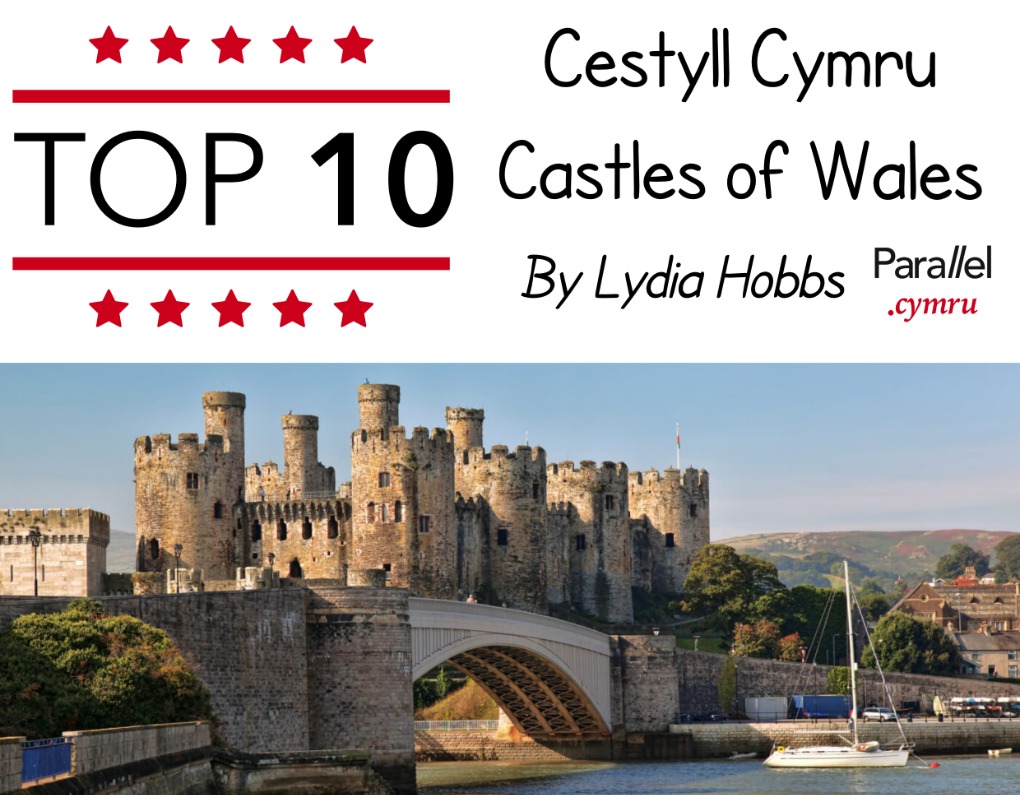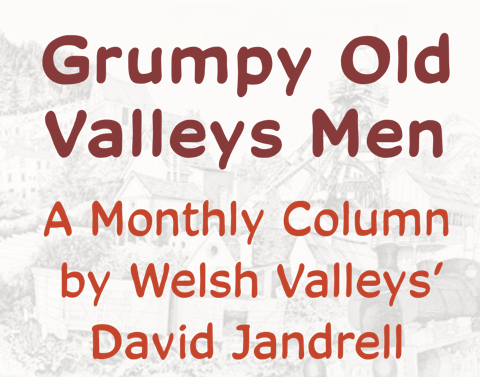Mae Cymru’n wlad fodern ond mae ganddi dreftadaeth odidog hefyd. Mae cestyll yn rhan bwysig o hanes Cymru ac mae dros 600 o gestyll yng Nghymru. Felly, ble bynnag yr ewch chi yng Nghymru, fyddwch chi byth yn bell o gastell.
Wales is a modern country but it also has a magnificent heritage. Castles are an important part of Welsh history and there are over 600 castles in Wales. Therefore, where you go in Wales, you will never be far from a castle.
By Lydia Hobbs
Castell Biwmares / Beaumaris Castle
Castell ar gyrion tref Biwmares, Ynys Môn yw Castell Biwmares. Mae’r castell yng ngofal Cadw, adran dreftadaeth Llywodraeth Cymru. Codwyd Castell Biwmares ar lan Afon Menai gan Edward I, Brenin Lloegr rhwng 1295 a 1298. Am ryw reswm, chafodd y castell byth ei gwblhau. Mae’r castell yn dechnegol berffaith ac wedi’i adeiladu ar ffurf cynllun ‘muriau o fewn muriau’ cywrain. Roedd Castell Biwmares yn y 13eg ganrif o ran datblygiadau technolegol yn cyfateb i long ofod yn glanio’n ddiseremoni ar Ynys Môn heddiw. Gellid cyrraedd y porth deheuol gan long, gan ganiatáu i'r castell gael ei gyflenwi'n uniongyrchol gan y môr.
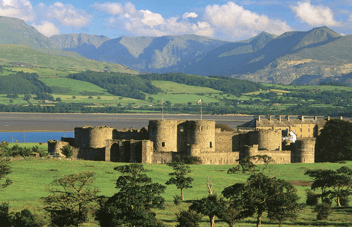
Castle Beaumaris is a castle on the outskirts of Beaumaris town, Anglesey. The castle is in the care of Cadw, the Welsh Government’s heritage department. Beaumaris Castle was built on the banks of the Menai River by Edward I, King of England, between 1295 and 1298. For some reason, the castle was never finished. The castle is technically perfect and built according to an ingenious ‘walls within walls’ plan. Beaumaris Castle was the 13th equivalent of a spaceship landing unceremoniously on Anglesey today. The south gate could be reached by ship, allowing the castle to be directly supplied by sea.
Castell Caernarfon / Caernarfon Castle
Caer canoloesol yw Castell Caernarfon. Lleolir yng nghanol tref Caernarfon, Gwynedd ac ar lannau Afon Menai ac Afon Seiant yw Castell Caernarfon. Mae o dan ofal Cadw. Codwyd y castell gan Edward I, Brenin Lloegr, rhwng 1283 a 1330. Mae gan y rhan fwyaf o gestyll dyrau crwn ond nid Caernarfon, sy gan dyrau polygon. Nid ar ddamwain y dewiswyd lleoliad y castell mawreddog hwn. Castell mwnt a beili Normanaidd a welwyd ar y safle yn flaenorol, a chyn hynny safai caer Rufeinig gerllaw. Heddiw, mae Castell Caernarfon yn atyniad twristiaid poblogaidd- ymwelwyd y safle gan bron 200,000 o bobl yn 2015.

Caernarfon Castle is a medieval fortress. It is located in Caernarfon, Gwynedd, on the banks of the Menai Strait and the River Seiont. It is looked after by Cadw. The castle was built by Edward I, King of England, between 1283 and 1330. Most castles have round towers, but not Caernarfon, as it has polygonal towers. The site of this great castle wasn’t chosen by accident. It had previously been the location of a Norman motte and bailey castle and before that a Roman fort stood nearby. Today, Caernarfon Castle is a very popular tourist attraction- almost 200,000 people visited the site in 2015.
Castell Caerffili / Caerphilly Castle
Castell yng nghanol tref Caerffili yn Ne Cymru yw Castell Caerffili. Castell cydganol canoloesol yw e. Heddiw, mae e dan ofal Cadw. Mae’r castell tua 12ha gyda ffos o’i gwmpas. Adeiladwyd y castell rhwng 1268 a 1271 gan Gilbert de Clare. Hwn yw’r castell mwyaf yng Nghymru a’r ail fwyaf ym Mhrydain, ar ôl Castell Windsor. Mae swyddogion Treftadaeth Llywodraeth Cynulliad Cymru yn dweud bod twr adfeiliedig y de-ddwyrain Castell Caerffili yn pwyso’n fwy na’r tŵr ym Mhisa, Yr Eidal.
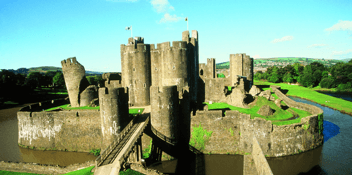
Caerphilly Castle is a castle in the centre of the town of Caerphilly in South Wales. It is a concentric, medieval castle. Today, it is under the care of Cadw. The castle is approximately 12ha, with a moat around it. The castle was built between 1268 and 1271 by Gilbert de Clare. It is the biggest castle in Wales and the second biggest in Britain, after Windsor Castle. Welsh Government Heritage officials say Caerphilly Castle’s ruined south east tower leans more than the leaning tower of Pisa, Italy.
Castell Caerdydd / Cardiff Castle
Lleolir y castell yng nghanol Caerdydd, wrth ymyl Parc Bute. Mae’n debyg taw ar ddiwedd y 50au OC y sefydlwyd y Gaer Rufeinig yng Nghaerdydd, gwelir olion y mur Rhufeinig heddiw. Ar ôl goresgyniad y Normaniaid, adeiladwyd gorthwr y Castell ar safle’r gaer Rufeinig. Roedd y castell yn perthyn i bobl wahanol dros y blynyddoedd. Wedyn, ym 1766, trosglwyddwyd y Castell trwy briodas i’r teulu Bute. Yn dilyn marwolaeth y pedwerydd Ardalydd Bute, penderfynodd y teulu roi’r Castell a llawer iawn o’i barcdiroedd i ddinas Caerdydd. Mae’r castell nawr yn boblogaidd i ymwelwyr.
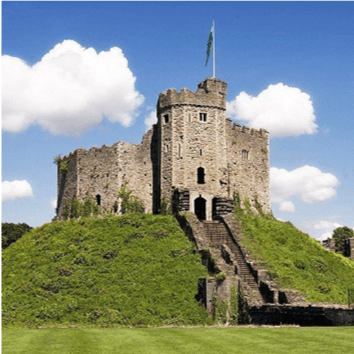
The castle is located in central Cardiff, next to Bute Park. It’s likely that the Roman Fort was established in Cardiff at the end of the 50s AD, the remains of the Roman wall can be seen today. After the Norman invasion, the castle’s keep was built on the site of the Roman fort. The castle belonged to different people over the years. Then, in 1766, the Castle was transferred by marriage to the Bute family. Following the death of the fourth Marquess of Bute, the family decided to give the Castle and many of its parklands to the city of Cardiff. The castle is now popular for visitors.
Castell Coch
Saif Castell Coch uwchben pentref Tongwynlais, ger Nantgarw, i'r gogledd o Gaerdydd. Gofalai Cadw am y castell heddiw. Er mai ar sylfeini hynafol y saif Castell Coch, mae’n gymharol fodern. Adeiladwyd Castell Coch yn y 1870au ar gyfer y 3ydd Ardalydd Bute a dyluniwyd y castell gan William Burges. Adeiladwyd y castell ar olion castell yr 13eg ganrif. Hefyd, mae ganddo fe’r addurniadau mewnol mwyaf nodedig. Nid oedd y castell yn addas i fod yn gartref parhaol, ac nid oedd hynny’n fwriad chwaith.
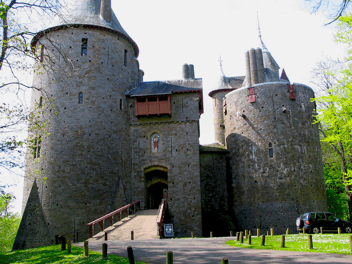
Castell Coch (Red Castle) stands above the village of Tongwynlais, near Nantgarw, to the north of Cardiff. Today, the castle is looked after by Cadw. Although Castell Coch stands on ancient foundations, it is relatively modern. Castell Coch was built in the 1870s for the 3rd Marquess of Bute and the castle was designed by William Burges. The castle was built in the remains of a 13th century castle. Also, it has the most remarkable interior design. The castle was not suitable for, nor was it intended to be, a permanent residence.
Castell Conwy / Conwy Castle
Castell Conwy yw castell canoloesol yn nhref Conwy ar lan Afon Conwy. Mae’r castell yng ngofal Cadw. Adeiladwyd y castell gan James o St George ar gyfer Edward I. Mae Castell Conwy ymhlith y cadarnleoedd canoloesol gorau sydd wedi goroesi ym Mhrydain. Amcangyfrifir bod £15,000 wedi’i wario yn adeiladu’r castell, y swm mwyaf a wariodd Edward mewn cyfnod mor fyr ar unrhyw un o’i gestyll yng Nghymru rhwng 1277 a 1307. Mae dau ragfur (pyrth cadarn), wyth tŵr enfawr a neuadd fawr siâp bwa yn rhai o’r nodweddion a welir o fewn ei siâp hir amlwg, sy’n rhannol o ganlyniad i’r graig frig gul y saif y castell arni.

Conwy Castle is a medieval castle in the town of Conwy on the banks of the Conwy river. The castle is in the care of Cadw. The castle was built by James of St George for Edward I. Conwy Castle is amongst the finest surviving medieval fortifications in Britain. An estimated £15,000 was spent building the castle, the largest sum Edward spent in such a short time on any of his Welsh castles between 1277 and 1307. Two barbicans (fortified gateways), eight massive towers and a great bow-shaped hall all sit within its distinctive elongated shape, due in part to the narrow rocky outcrop on which the castle stands.
Castell Cricieth / Criccieth Castle
Castell canoloesol Cymreig yw Castell Cricieth, sy'n sefyll ar glogwyn ar lan Bae Tremadog, ar ymyl tref Cricieth, Gwynedd, yng ngogledd Cymru. Mae Castell Cricieth yn sefyll ar bentir gyda’r môr yn gymar cyson iddo. Mae’r castell o dan ofal Cadw. Mae gan Gastell Cricieth dri thŵr a gysylltir gan fur amgylchynol. Codwyd y castell yn y drydedd ganrif ar ddeg gan Llywelyn ap Iorwerth, Tywysog Gwynedd a'i ŵyr, Llywelyn ap Gruffydd. Cafodd y castell ei gipio a’i losgi n ystod gwrthryfel Owain Glyndŵr. Hefyd, mae’n bosibl mai Castell Cricieth roddodd yr enw ar y dref yn hytrach na’r gwrthwyneb.

Criccieth Castle is a Welsh medieval castle, which stands on a cliff on the banks of Tremadog Bay, near the town of Criccieth, Gwynedd, in North Wales. Criccieth Castle is perched on a headland with the sea as its constant bedfellow. The castle in under the care of Cadw. Criccieth Castle has three towers which are connected by a circular wall. The castle was built in the thirteenth century by Llywelyn ap Iorwerth, the Prince of Gwynedd and his grandson, Llywelyn ap Gruffydd. The castle was captured and burned during the rebellion of Owain Glyndŵr. Also, it’s likely that Criccieth Castle gave the name to the town rather than the other way around.
Castell Harlech / Harlech Castle
Saif Castell Harlech uwchben dref Harlech a Bae Tremadog yn ne Gwynedd, Cymru. Heddiw, mae’r castell o dan ofal Cadw. Adeiladwyd y castell gan Edward I, Brenin Lloegr, rhwng 1283 a 1290. Mae'r castell yn adeilad cryf iawn uwchben craig fawr, gyda grisiau yn arwain at lan y môr. Mae’r bont ‘arnofio’ newydd yn y castell yn golygu bod pawb yn gallu cael mynediad i’r castell. Mae’r bont yn cysylltu’r castell gyda’r ganolfan ymwelwyr newydd yn hen adeilad Gwesty’r Castell.

Harlech Castle stands above the town of Halech and Tremadog Bay in south Gwynedd, Wales. Today, the castle is under the care of Cadw. The castle was built by Edward I, King of England, between 1283 and 1290. The castle is a strong building above a large rock with stairs leading to the sea. The newly installed ‘floating’ bridge at the castle means that everyone can gain entrance to the castle. The bridge connects the castle with the new visitor centre in the former Castle Hotel building.
Castell Penfro / Pembroke Castle
Saif Castell Penfro ar lân yr afon yng nghanol tref Penfro. Cychwynnwyd ar y gwaith o godi’r castell ym 1093 gan Roger o Drefaldwyn yn gastell pren, fel rhan o ymdrech y Normaniaid i oresgyn Cymru. Mae Castell Penfro yn nodedig fel yr unig gastell ym Mhrydain a adeiladodd dros ogof naturiol. Roedd yr ogof o dan y castell yn arfer cael ei defnyddio fel storfa a dywedwyd eu bod wedi darganfod darnau arian Rhufeinig yn yr ogof. Ni chipiwyd y castell gan y Cymry er gwaethaf sawl ymosodiad.
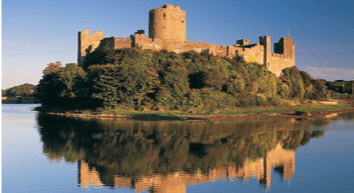
Pembroke Castle stands on the river bank in the centre of Pembroke town. The work on building the castle began in 1093 by Roger of Montgomeryshire as a wooden castle, as part of the Normans’ effort to conquer Wales. Pembroke Castle is notable as the only castle in Britain to be built over a natural cave. The cave under the castle used to be used for storage and it has been said that they have found Roman coins in the cave. The castle was not taken by the Welsh despite many attacks.
Castell Rhaglen / Raglan Castle
Castell i’r gogledd o bentref Rhaglen, Sir Fynwy yw Castell Rhaglen. Mae’n gastell o’r canol oesoedd hwyr. Dechreuwyd y gwaith adeiladu ar y castell ym 1435 ar gyfer Syr William ap Thomas, sy’n gyfnod cymharol hwyr o ran adeiladu cestyll. Yn wreiddiol, mae’n debygol i’r castell hwn ddilyn cynllun mwnt a beili. Gwelir rhai olion yr hanes cynnar hwn yna o hyd. Roedd y castell yn fwy o ddatganiad o gyfoeth nag o bresenoldeb milwrol. Serch hynny, llwyddodd i wrthsefyll lluoedd seneddwr am dair wythnos ar ddeg, yn un o warchaeau olaf y Rhyfel Cartref. Heddiw, mae’r castell yn cael ei ofal gan Cadw.

Raglan Castle is a castle to the north of the village of Rhaglen, Monmouthshire. It is a castle from the late Middle Ages. The building work on the castell started in 1435 for Sir William ap Thomas, which is comparatively late in terms of building castles. Originally, it was likely that this castle followed a motte-and-bailey design. One can still see some remains of this early history. The castle was more of a statement of wealth than for military presence. Despite that, it still held off parliamentarian forces for thirteen weeks, in one of the last sieges of the Civil War. Today, the castle is looked after by Cadw.

